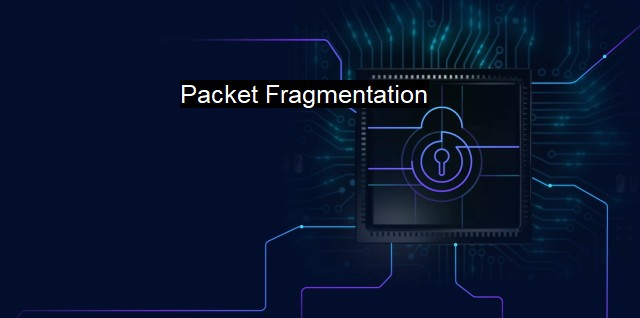What is Packet Fragmentation?
Defending against Cybersecurity Threats: Navigating Packet Fragmentation and the Importance of Antivirus Protection in Computer Networks
Packet fragmentation is a fundamental concept in the realm of computer networking and cybersecurity. Notably, in the context of computer networks, packets refer to the basic unit of data that are transferred over a network. Packet fragmentation, therefore, pertains to the process where data packets are divided into smaller pieces, as a part of network congestion management and circumvention of limitations on data transmission sizes.Primarily, packet fragmentation comes into play in situations where the data packet that needs to be transmitted exceeds the maximum transmission unit (MTU) enforced by the network protocols. The MTU, which stands for Maximum Transmission Unit, refers to the maximum size that a single network packet can carry. Whenever a data packet surpasses the MTU size, the network router engages into packet fragmentation mechanism. It divides the user data into smaller packets known as fragments, then these fragments are independently routed to the final destination. At the receiving end, these fragments are re-assembled back into the original data packet.
While the packet fragmentation process sounds relatively simple and efficient in maneuvering around network size limitations, it also ushers in significant concerns in the realm of cybersecurity. As part of complex network architecture, where several computational devices and servers connect with each other, such fragmentation can become a potential vulnerability, open to exploitation by malevolent entities or cybercriminals.
Many cybersecurity threats, like Denial of Service (DoS) and Distributed Denial of Service (DDoS) attacks, utilize the concept of packet fragmentation to unduly inundate a network. the attacker can utilize fraggle or smurf threats which are types of DDoS attacks where the offending party sends a large amount of fragmented packets to the targeted network, leading to overwhelming traffic that slows down or completely incapacitates the network.
The process of packet reassembly can itself be a security threat. Packets from different sources could potentially be mixed up during the reassembly process, leading to a phenomenon termed as "IP Fragmentation Overlapping". In such cases, an attacker could intentionally send fragmented packets where the reassembly would result in a packet that is different from any of the original packets, potentially causing unauthorized data access, or serious disruptions to the normal functioning of the network.
Antivirus systems play a significant role in mitigating packet fragmentation threats. They are designed to detect suspicious characteristics in data packets during the reassembly process. They scan for signature patterns typically associated with malicious fragmented packets and employ machine learning to predict and respond to novel threats.
In modern cybersecurity approach, Intrusion detection systems (IDSs) are used in networks to identify anomalous packet behavior that may pose a security threat. For instance, there are some IDSs that ck for abnormal fragmentation patterns. These patterns could be an indication of an impending leave DoS, exploit, or any form of network-based attack. In such cases, the IDS triggers an alarm and provides detailed insight about the threat to help network administrators take necessary preventative measures.
While packet fragmentation is a useful method in ensuring data transmission across networks, it can be seen as a double-edged sword. It poses potential vulnerabilities that can be exploited for cyberattacks. Therefore, reliable antivirus systems and advanced Intrusion Detection Systems are essential to ensure privacy and security in the digital space. Despite these challenges, a comprehensive understanding of packet fragmentation and its consequent threats is instrumental in the pursuit of building robust, reliable, and secure networking infrastructures.

Packet Fragmentation FAQs
What is packet fragmentation?
Packet fragmentation is the process of breaking up large data packets into smaller ones for transmission over a network. This is done to accommodate the maximum transmission unit (MTU) size of different network devices.What is the impact of packet fragmentation on cybersecurity?
Packet fragmentation can be exploited by attackers to bypass security measures such as firewalls and intrusion detection systems. This is because the data can be fragmented into multiple packets that may not be inspectable by these security measures, allowing malicious payloads to be delivered undetected.How do anti-virus software handle packet fragmentation?
Anti-virus software can handle packet fragmentation by reassembling the fragmented packets and analyzing the complete data payload. This can help detect and block malicious data that may have been disguised through fragmentation.What are some best practices to mitigate the risks associated with packet fragmentation?
Some best practices to mitigate risks associated with packet fragmentation include: reducing reliance on fragmented packets where possible, using security tools that can reassemble fragmented packets before inspection, and implementing network segmentation to limit the impact of successful attacks.| | A | | | B | | | C | | | D | | | E | | | F | | | G | | | H | | | I | | | J | | | K | | | L | | | M | |
| | N | | | O | | | P | | | Q | | | R | | | S | | | T | | | U | | | V | | | W | | | X | | | Y | | | Z | |
| | 1 | | | 2 | | | 3 | | | 4 | | | 7 | | | 8 | | |||||||